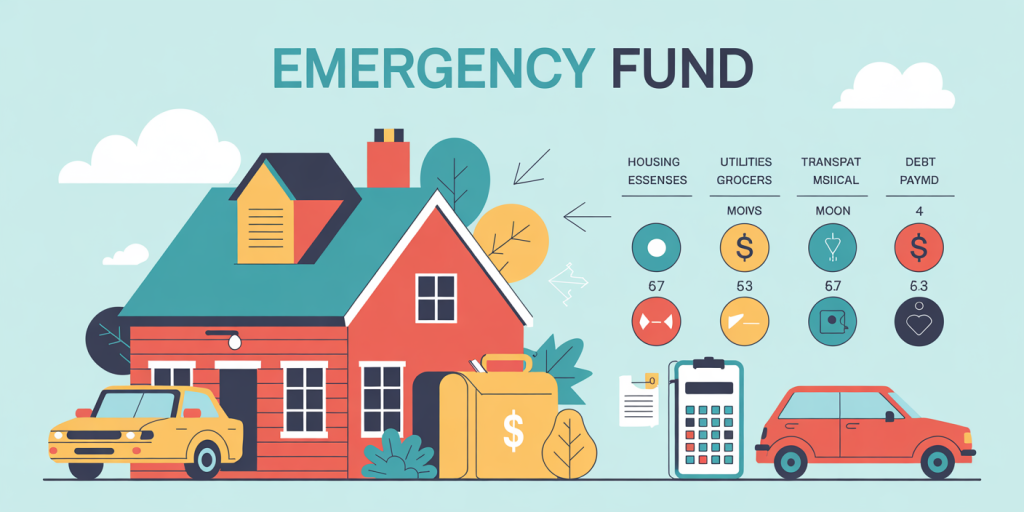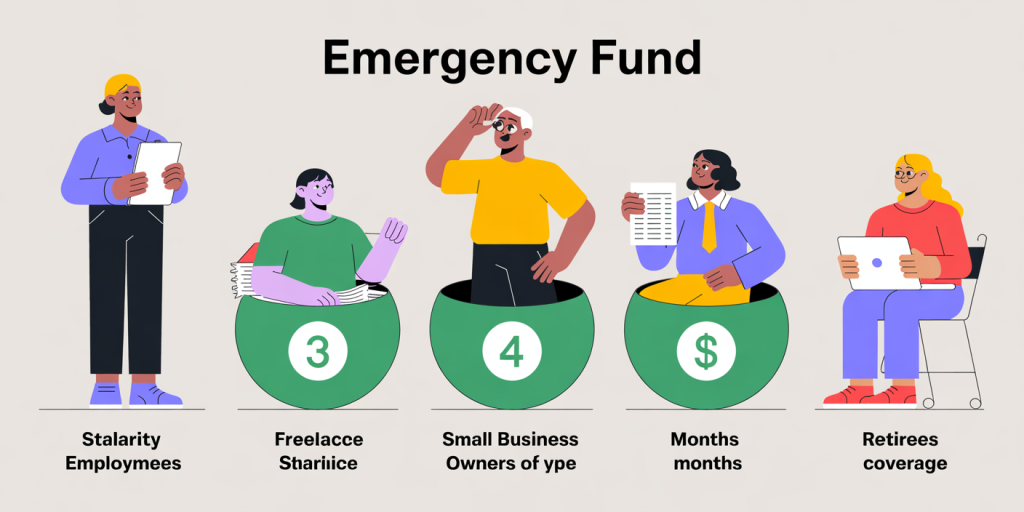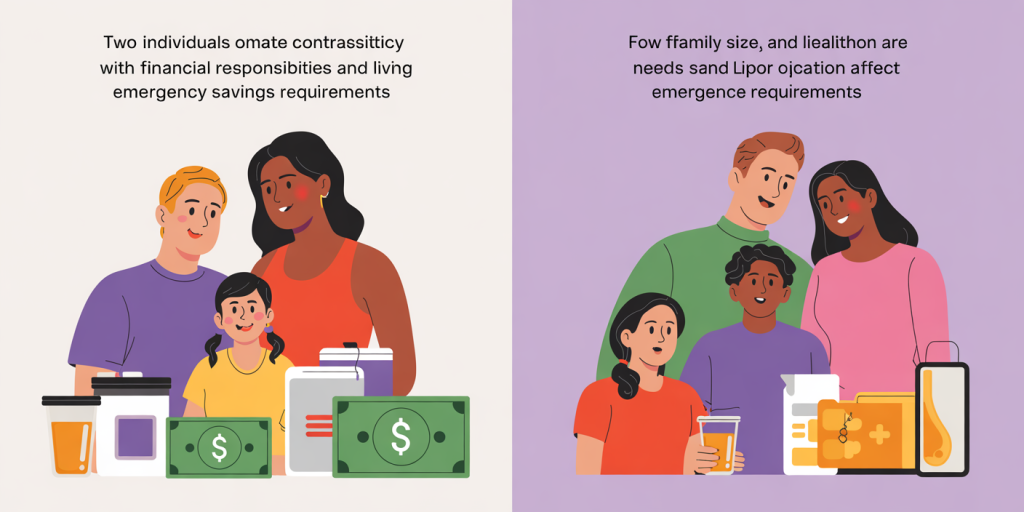How Much Should You Have Saved for Emergencies? A Practical Calculation for Different Income Levels and Lifestyles
Anúncios
Financial resilience is a critical component of modern life, especially given the unpredictable nature of emergencies ranging from sudden job loss and medical crises to unexpected home repairs. A common rule of thumb is to keep an emergency fund covering three to six months’ worth of living expenses, but this guideline does not serve everyone equally. Income levels, lifestyle choices, debt obligations, and local cost of living all influence how much you truly need saved for emergencies. This article explores how to calculate an appropriate emergency fund tailored to your financial situation, backed by practical examples and comparative data.

Why an Emergency Fund Is Essential: Context and Basic Considerations
Anúncios
Unexpected expenses can derail financial stability quickly. According to the Federal Reserve’s 2022 Report on the Economic Well-Being of U.S. Households, nearly 36% of adults said they would cover an unexpected $400 expense by borrowing, selling something, or not paying bills on time, underscoring the lack of sufficient emergency savings among many Americans.
An emergency fund acts as a financial buffer, preventing the reliance on high-interest debt such as credit cards or payday loans in times of crisis. However, the universal recommendation of saving three to six months of expenses may be insufficient or excessive depending on individual circumstances. For example, a high-income earner with stable employment in a low-cost city may need fewer months of back-up savings than a freelancer with fluctuating income and a large family in an expensive urban area.
Calculating Your Monthly Essential Expenses: The Foundation of Your Emergency Fund
To determine how much you need saved, start by calculating your essential monthly expenses — the non-negotiable costs you must pay regardless of your financial situation. These include: Housing (rent or mortgage payments) Utilities (electric, water, internet, phone) Groceries Transportation costs (fuel, public transit) Insurance premiums (health, auto) Minimum debt payments Medical expenses Childcare or education if applicable
For example, consider Sarah, a 32-year-old teacher earning $65,000 annually in Austin, Texas. Her monthly essentials break down as follows: $1,200 rent, $300 groceries, $150 utilities, $100 transportation, $200 insurance, $400 medical costs, and $250 debt minimum payments. Her total monthly essential expenses are around $2,600.
Creating an accurate list of these essentials is crucial because emergency funds should cover what you realistically cannot postpone or avoid. Non-essential discretionary spending like dining out, entertainment, and vacations should be excluded since these can be cut back temporarily.
Emergency Fund Size Based on Income Stability and Employment Type
The size of your emergency savings should correlate strongly with income predictability and employment security. Individuals with stable, salaried jobs often require a smaller emergency fund compared to freelancers, contractors, or small business owners with irregular earnings.

A practical benchmark chart based on income source and stability:
| Income Type | Recommended Emergency Fund Coverage |
|---|---|
| Stable Salaried Employee | 3-6 months of essential living expenses |
| Gig Worker & Freelancer | 6-9 months of essential living expenses |
| Small Business Owner | 9-12 months of essential living expenses |
| Retiree with fixed income | 3-6 months, adjusted for healthcare needs |
For instance, Javier, a freelance graphic designer with fluctuating monthly income, has calculated that his monthly essentials average $3,000. Because of variability and no unemployment benefits, Javier aims to save nine months’ worth of expenses, totaling $27,000, as a cushion against potential dry spells.
Conversely, Lisa, a government employee with a stable $85,000 salary, targets five months of essentials, $2,800 monthly, totaling $14,000. She views this as sufficient based on her reliable income, comprehensive benefits, and low debt.
Lifestyle Factors That Influence Emergency Savings Needs
Lifestyles can dramatically affect your emergency fund requirements. Single individuals without children generally have fewer financial responsibilities, while families with multiple dependents face higher fixed costs like childcare, education, and healthcare.
Health status is another important factor. Individuals with chronic medical conditions or who anticipate high medical bills may require more extensive savings. Additionally, geographic location and cost of living impact the amount needed.
For example, compare two individuals with identical incomes but different lifestyles: Mark, a single software engineer in Omaha, Nebraska, spends about $1,800 monthly on essentials, targeting 4 months of expenses, or $7,200. Karen, a married nurse with two children in San Francisco, faces $5,000 in monthly essentials due to higher housing costs and childcare, and aims for six months of expenses, equaling $30,000.
This disparity highlights that emergency fund recommendations should flexibly adapt to personal circumstances rather than adhere to one-size-fits-all guidelines.
Real-World Case Studies Illustrating Emergency Fund Decisions
Case 1: The Young Couple with Growing Expenses
David and Maria recently married and are expecting their first child. Both work as mid-level managers earning combined $110,000 annually but have $2,500 in monthly rent and $750 in childcare expected soon. They decide to increase their emergency fund from 3 months to 6 months of anticipated new expenses.
They calculate:
| Expense Category | Amount (USD) |
|---|---|
| Rent and utilities | 2,500 |
| Groceries | 600 |
| Health insurance | 400 |
| Childcare | 750 |
| Transportation | 300 |
| Minimum debt payments | 300 |
| Total Monthly Essentials | 4,850 |
Six months’ coverage equals $29,100. By boosting their emergency fund in anticipation of new financial responsibilities, they protect themselves against potential employment or health crises.
Case 2: The Freelancer with Income Fluctuations
Priya is a freelance writer whose monthly income varies widely from $2,000 to $6,000. Her fixed monthly essentials average $2,400. She opts to keep a 9-month cushion ($21,600) for lean months. Priya’s savings strategy balances maintaining liquidity with investing surplus income after reaching this emergency fund goal.

Priya’s financial discipline provides reassurance despite income volatility, illustrating how professionals in the gig economy progress towards suitable safety nets.
Comparative Tables: Emergency Funds by Scenario
The following table summarizes emergency fund sizes for several hypothetical earners based on lifestyle and income characteristics:
| Profile | Monthly Essentials (USD) | Months of Coverage | Recommended Emergency Fund (USD) |
|---|---|---|---|
| Single College Grad | 1,200 | 3 | 3,600 |
| Dual-Income Family, No Kids | 3,000 | 4 | 12,000 |
| Freelancer with Dependents | 3,500 | 9 | 31,500 |
| Small Business Owner | 5,000 | 12 | 60,000 |
This table emphasizes how both income volatility and lifestyle complexity raise the financial safety net requirement significantly.
Future Perspectives: Adapting Emergency Funds in a Changing Economy
Economic trends such as inflation, rising healthcare costs, and evolving job markets make emergency fund planning a dynamic task. The U.S. inflation rate averaged around 8% in 2022, significantly increasing cost of living and highlighting the importance of regularly revisiting emergency fund adequacy.
Additionally, the rise of the gig economy means a growing segment of the population faces income instability, requiring larger emergency savings or alternative financial buffers such as credit lines or family support.
Technology-enabled tools now allow automated savings plans and better expense tracking, helping individuals maintain optimized emergency funds without excessive delay. Financial advisors increasingly recommend personalized savings goals, factoring in health insurance deductibles, debt repayment strategies, and contingency plans beyond basic expenses.
Given geopolitical uncertainties and increasing frequency of natural disasters, such as hurricanes and wildfires affecting housing markets, emergency fund models may evolve to include dedicated disaster funds for specific risks in certain regions.
Proactive financial education and tailored planning will be essential for individuals to build resilient emergency funds appropriate for their unique circumstances, reinforcing the broader economic safety net.
—
In summary, the appropriate size of an emergency fund varies widely based on essential monthly expenses, income stability, employment type, and lifestyle. By calculating real-world expenses and considering personal circumstances, you can determine a savings target that offers genuine security rather than relying on generic rules. The future points toward increasingly personalized and flexible approaches to emergency savings as economic volatility and lifestyle diversity expand. Regularly reviewing and adjusting your emergency fund in response to life changes will ensure this financial cushion remains sufficient to safeguard your financial wellbeing over time.
